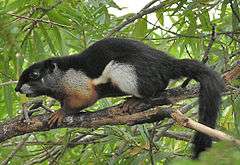Bhutan giant flying squirrel
| Bhutan Giant Flying Squirrel | |
|---|---|
 | |
| Scientific classification | |
| Kingdom: | Animalia |
| Phylum: | Chordata |
| Class: | Mammalia |
| Order: | Rodentia |
| Family: | Sciuridae |
| Genus: | Petaurista |
| Species: | P. nobilis |
| Binomial name | |
| Petaurista nobilis (Gray, 1842) | |
The Bhutan giant flying squirrel (Petaurista nobilis) is a species of rodent in the family Sciuridae. It is one of the largest among the flying squirrels.[2]
Distribution
It has a narrow range restricted to central Nepal, Sikkim and western Arunachal Pradesh in India, and Bhutan.[3] It could occur in neighbouring forests in southern Tibet and northern Bangladesh, although it has not yet been reported from these areas.
Identification
The squirrel has bright chestnut-brown upper parts with orange tips to some of the hairs and pale rufous underparts. It is pale fulvous on the top of the head, shoulders, and in a narrow streak in the middle of the upper parts.[3]
It was previously considered as a sub-species of Hodgson's giant flying squirrel but later elevated to a full species based on its distinctness.[4][5] Two sub-species are recognised: P n. nobilis and P n. singhei.
Ecology and habitat
Its natural habitat is temperate broadleaf forests typically recorded between 1500 m to 3000 m elevation, but could also occur in contiguous coniferous forests.[3] Reports from Arunachal Pradesh 100 km east of its previous eastern limits to the range of this species indicate possible larger range in North-east India.[3] It appears to breed between March and April.[2]
References
- ↑ Thapa, J.; Molur, S. & Nameer, P. O. (2008). "Petaurista nobilis". IUCN Red List of Threatened Species. Version 2008. International Union for Conservation of Nature. Retrieved 6 January 2009.
- 1 2 Stephen, Jackson; Peter Schouten. Gliding mammals of the world. Collingwood, Vic.: CSIRO Pub. p. 128. ISBN 978-0643092600.
- 1 2 3 4 Squirrels of the world. Baltimore: Johns Hopkins University Press. 2012. p. 116. ISBN 9781421404691.
- ↑ Ellerman, J R (August 1947). "A Key to the Rodentia Inhabiting India, Ceylon, and Burma, Based on Collections in the British Museum. Part I". Journal of Mammalogy. 28 (3): 254. doi:10.2307/1375176. JSTOR 1375176.
- ↑ Srinivasulu, Chelmala; Bhargavi Srinivasulu. South Asian mammals : their diversity, distribution, and status (2012 ed.). New York: Springer.



.jpg)